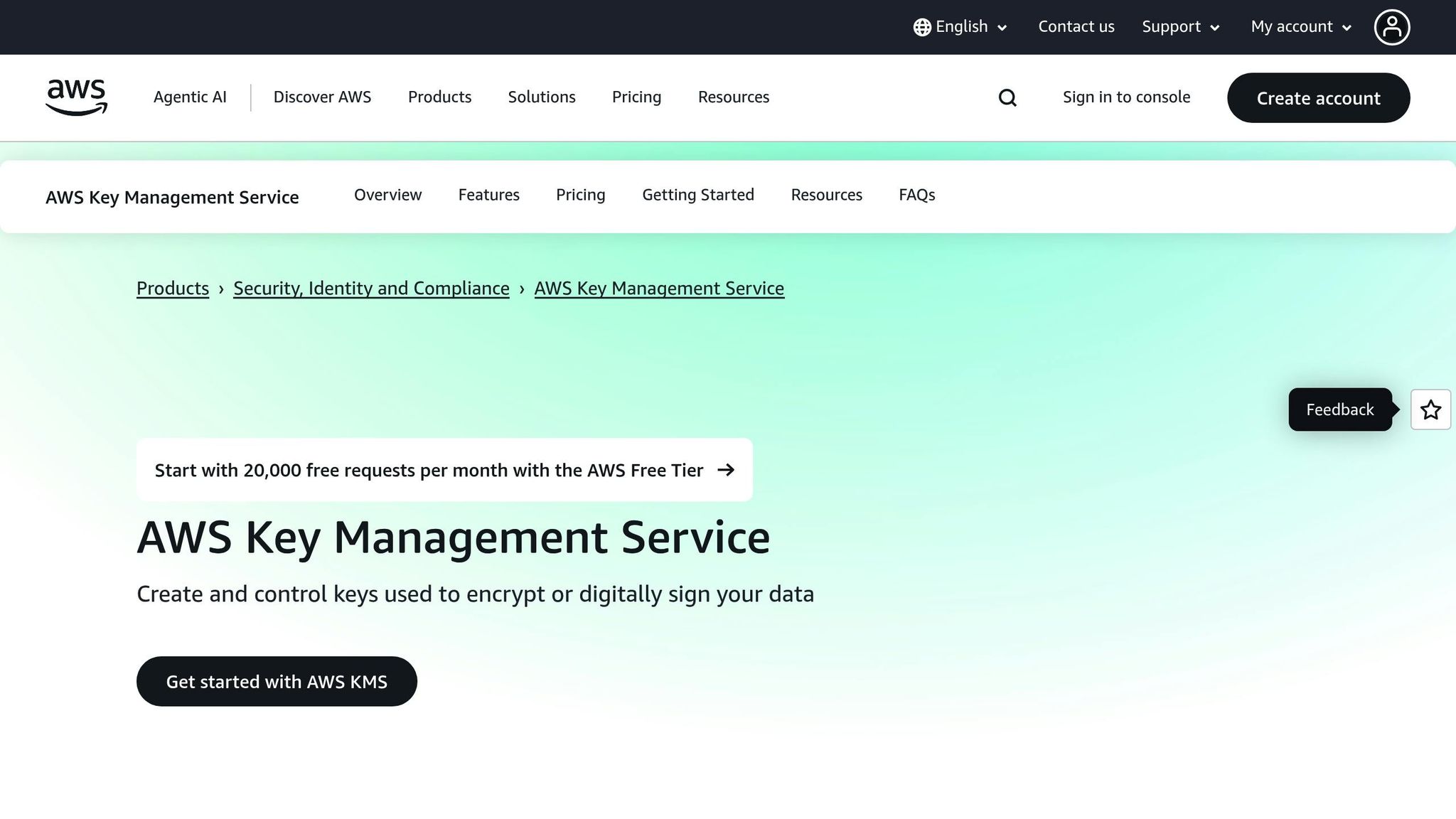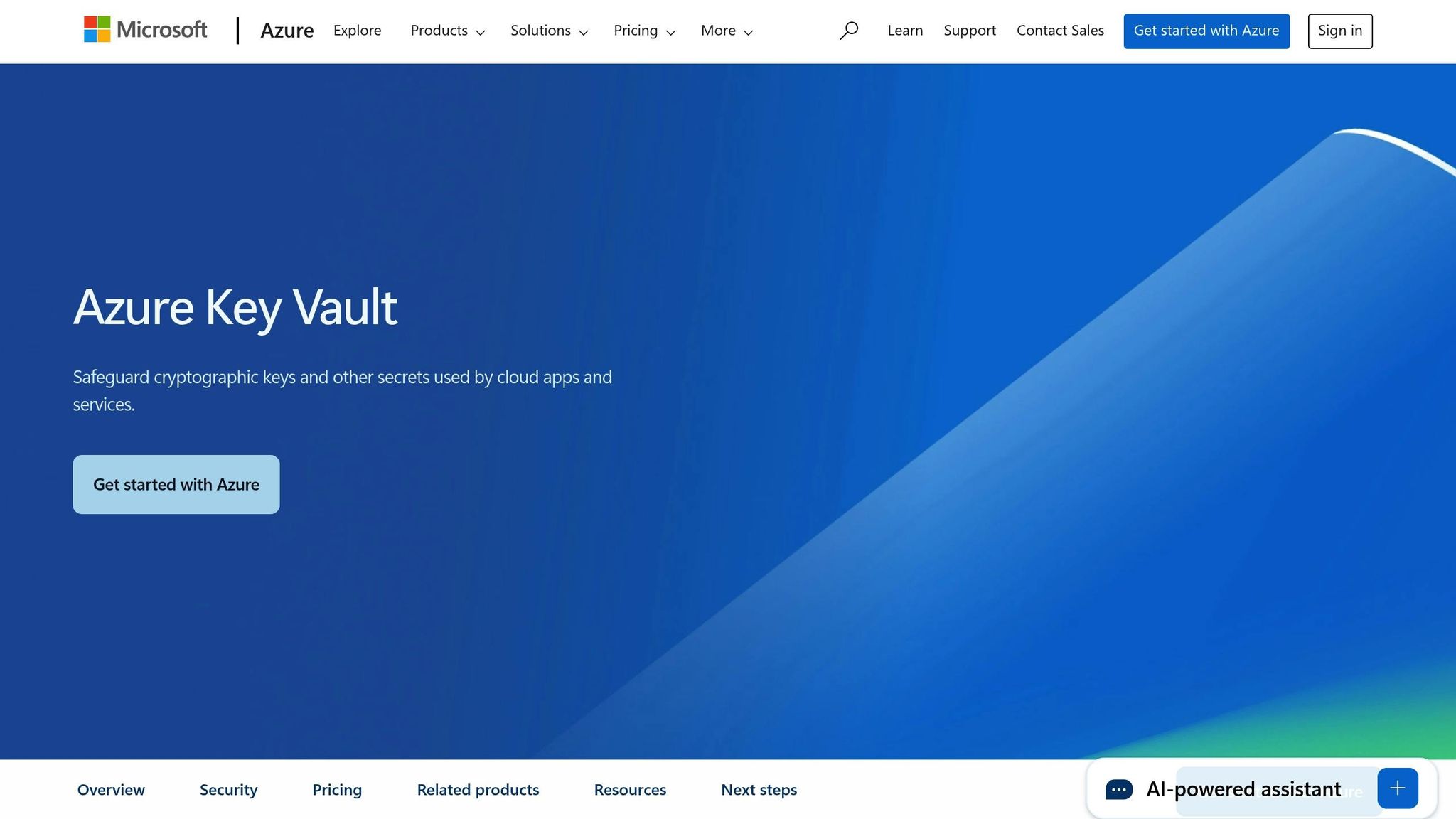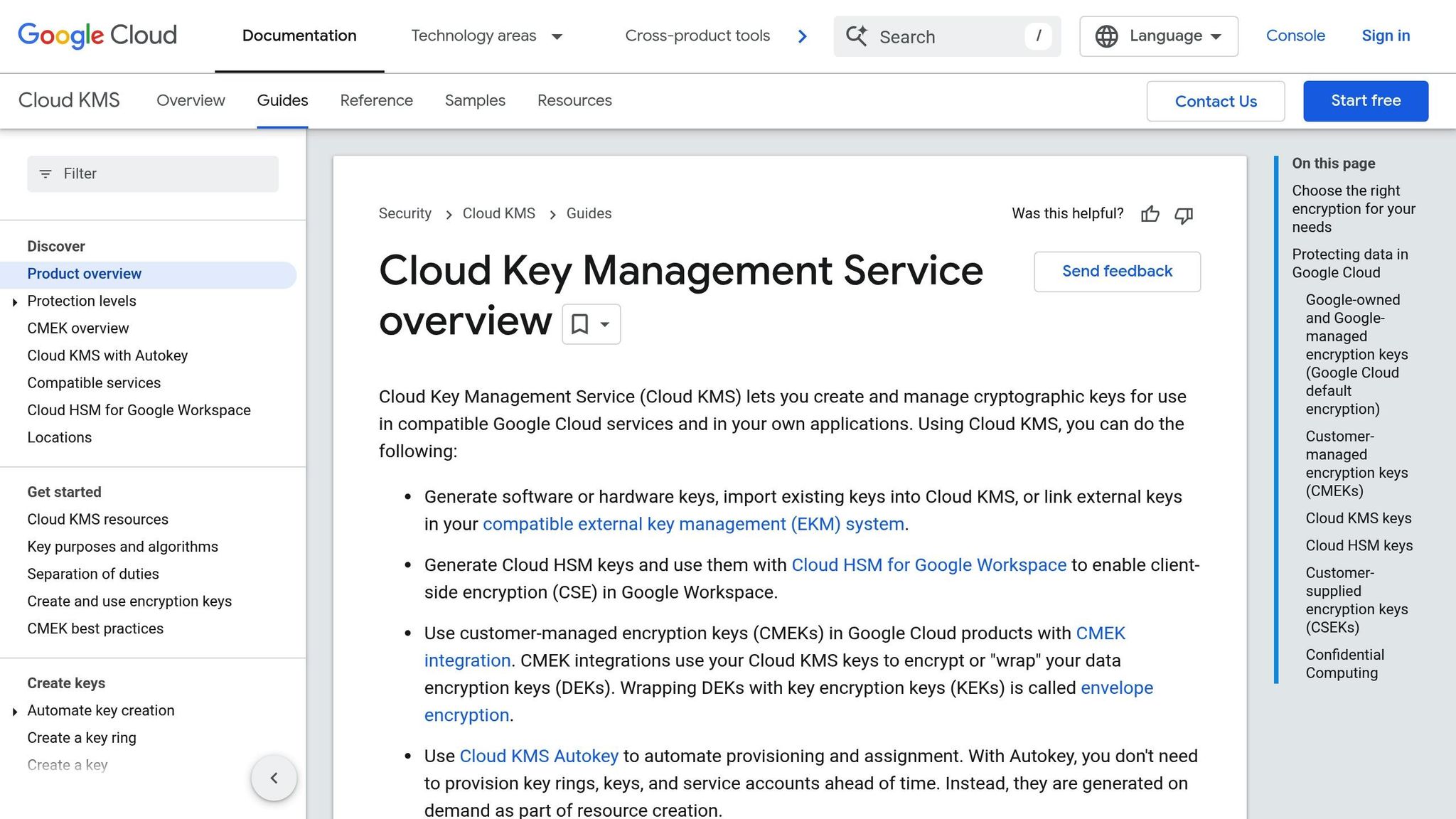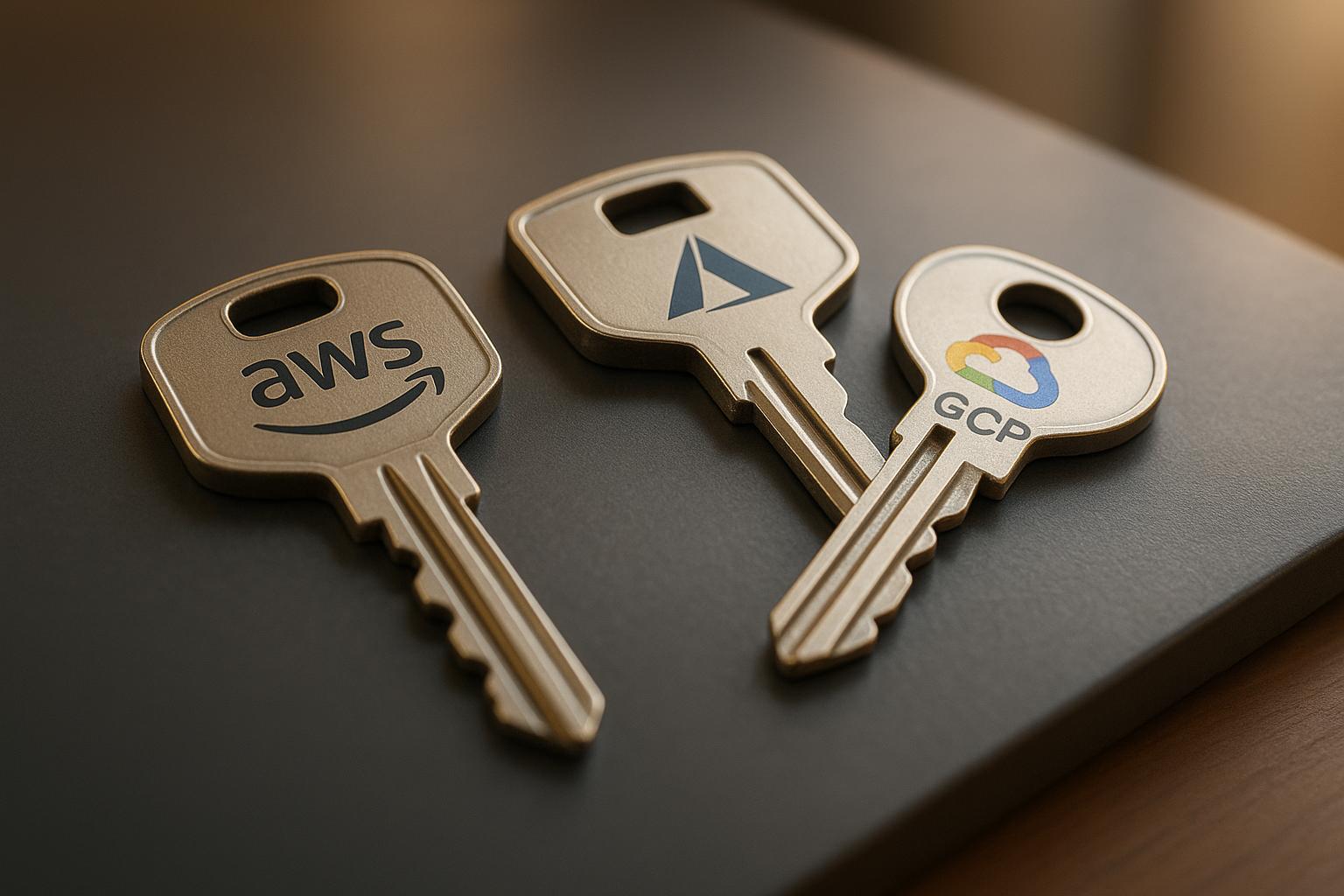Cloud key management is essential for securing data in AWS, Azure, and GCP. It involves generating, storing, and retiring encryption keys, which protect sensitive information like payment details, personal records, and intellectual property. Each platform - AWS Key Management Service (KMS), Azure Key Vault, and GCP Cloud KMS - offers tools to manage encryption keys effectively, but they differ in features, integrations, and compliance options.
Key points to know:
- AWS KMS integrates with over 100 AWS services, supports detailed access controls, and uses envelope encryption for performance.
- Azure Key Vault excels in certificate management and integrates with Active Directory for user management.
- GCP Cloud KMS provides global key distribution, IAM-based access, and flexible key rotation schedules.
For UK organisations, compliance with GDPR, PCI DSS, and other regulations is critical. Encryption keys often need to stay within UK or EU data centres, and automated key rotation and strict access controls are necessary to meet regulatory standards. Managing keys across multiple cloud providers adds complexity, including inconsistent permission models and monitoring challenges.
Quick Comparison:
| Feature | AWS KMS | Azure Key Vault | GCP Cloud KMS |
|---|---|---|---|
| Integration | 100+ AWS services | Microsoft ecosystem | Limited third-party support |
| Key Rotation | Automatic (1-year) | Configurable | Flexible schedules |
| Access Control | IAM policies | Active Directory integration | IAM-based |
| Data Residency | Broad compliance options | UK/EU regions | Precise location control |
| Certificate Management | Limited | Strong support | Not a core feature |
To strengthen security, automate key rotation, enforce least privilege access, and centralise monitoring. For multi-cloud setups, use tools like Terraform for consistent configurations and identity federation for unified access control. Proper key management ensures compliance, reduces risks, and protects your data across AWS, Azure, and GCP.
From Beginner to AWS KMS Pro: Mastering Key Management!
Key Management Services: AWS, Azure, and GCP
The leading cloud providers - AWS, Azure, and GCP - offer powerful key management solutions designed to safeguard data and align with stringent security standards. These services are tailored to secure encryption keys and ensure data protection across a variety of use cases.
AWS Key Management Service (KMS)

AWS KMS is a versatile tool that encrypts data at rest across services like Amazon S3, EBS, RDS, Aurora, and Redshift [2]. It also secures API keys, tokens, and environment variables in serverless applications built using Lambda [2]. For auditing purposes, it encrypts CloudTrail logs to maintain their integrity [2]. Additionally, AWS KMS supports client-side encryption [1][2] and helps protect data within DynamoDB tables [3].
Azure Key Vault

Azure Key Vault is designed to manage sensitive information such as tokens, passwords, certificates, and API keys [4][5]. It simplifies the provisioning and deployment of TLS/SSL certificates, offering features like auto-renewal and revocation handling [4][5]. Furthermore, it integrates seamlessly with Azure Disk Encryption, SQL Server (supporting Always Encrypted and Transparent Data Encryption), and Azure App Service [4].
GCP Cloud KMS

GCP Cloud KMS provides organisations with the ability to use customer-supplied encryption keys (CSEK), granting full control over encryption materials. It incorporates IAM-based access control, supports multi-region key distribution to meet data residency needs, and offers automatic key rotation based on customisable schedules. These capabilities set the foundation for a deeper comparison of key features across providers in the following section.
Feature Comparison Across Cloud Providers
Understanding how AWS KMS, Azure Key Vault, and GCP Cloud KMS differ can help organisations shape their encryption strategies effectively. Each platform brings its own features and strengths to the table, catering to varied security needs and operational setups.
Key Features and Security Controls Comparison
Each of these services - AWS KMS, Azure Key Vault, and GCP Cloud KMS - offers distinct advantages when it comes to encryption models, access controls, and compliance.
AWS KMS: Known for its granular permissions, AWS KMS allows administrators to define detailed access controls using IAM policies. It supports both AWS-managed and customer-managed keys and employs envelope encryption to handle large datasets efficiently without compromising security. With integrations across more than 100 AWS services and detailed audit trails available through CloudTrail, it’s a strong choice for organisations deeply tied to the AWS ecosystem.
Azure Key Vault: This platform shines in environments where certificate management is critical. It integrates seamlessly with Active Directory, making user management straightforward, and offers hardware security module (HSM) backing in its premium tiers. Azure Key Vault combines secrets and key management into a unified interface, which simplifies operations, especially in hybrid environments where on-premises systems need to interact with cloud-based key management.
GCP Cloud KMS: GCP stands out with its global key distribution model and robust IAM integration. It supports both customer-supplied encryption keys (CSEK) and customer-managed encryption keys (CMEK), providing flexibility for organisations that prefer to retain control over their encryption keys. Its configurable automatic key rotation allows organisations to tailor rotation schedules to their specific security policies, offering a high degree of customisation.
In summary, AWS leads with envelope encryption for performance, Azure offers unified management for secrets and keys, and GCP provides unmatched geographic control over key storage locations.
Platform Advantages and Limitations
Looking beyond features, each platform has operational pros and cons that organisations should consider:
AWS KMS: Its extensive service integration makes it an ideal choice for businesses already invested in AWS. Fine-grained key policies allow precise control over who can access and manage keys, but this level of detail can become challenging to maintain in larger organisations. Additionally, using keys across regions introduces extra latency, which could be a consideration for global operations.
Azure Key Vault: A strong option for enterprises using Microsoft infrastructure, Azure Key Vault simplifies user management through its Active Directory integration. Its unified approach to managing secrets, keys, and certificates reduces complexity, and HSM-backed keys in premium tiers add an extra layer of security. However, Azure’s ecosystem is smaller compared to AWS, which may require additional effort to integrate with non-Microsoft services.
GCP Cloud KMS: GCP’s pricing model is straightforward, based solely on usage, which can be cost-effective for organisations with lower key usage. Its global key distribution and flexible automatic key rotation make it a good fit for distributed applications. However, GCP’s smaller market share means fewer third-party integrations and a smaller user community, which might pose challenges for troubleshooting and support.
When it comes to costs, AWS charges a monthly fee per key along with usage-based fees, Azure offers predictable pricing for certificates, and GCP’s usage-based billing can be economical for organisations with minimal key activity.
For UK organisations, all three platforms provide data residency options within European regions to comply with GDPR regulations. However, GCP offers the most precise control over data location, while AWS boasts the widest range of compliance certifications, including those specific to the UK.
Need help optimizing your cloud costs?
Get expert advice on how to reduce your cloud expenses without sacrificing performance.
Secure Key Management Best Practices
To maintain strong security across platforms, effective cloud key management requires clear policies, strict access controls, and constant monitoring. Below are some essential practices to help ensure your key management strategy is robust and reliable.
Key Rotation and Lifecycle Management
Automating key rotation is a cornerstone of secure key management. Organisations should establish automated schedules that align with their security policies and compliance requirements. Each major cloud provider offers tools to simplify this process:
- AWS KMS: Automatically rotates customer-managed keys every year.
- Azure Key Vault: Provides configurable rotation for both keys and certificates, allowing custom timeframes.
- GCP Cloud KMS: Offers flexible rotation schedules tailored to the sensitivity of your data.
By automating these processes, you minimise the risk of outdated or compromised keys.
Access Control and Permissions
The principle of least privilege should guide every access decision. Instead of granting broad permissions, adopt role-based access controls (RBAC) that align with specific business needs. Prioritising business roles over technical ones can create a more manageable and sustainable permissions framework [8].
Separation of duties is another critical measure. Tasks like key creation, management, and usage should be handled by different individuals or systems to reduce the risk of unauthorised access [9]. Additionally, leveraging identity federation ensures consistent authentication across platforms through centralised identity providers [8].
For service accounts and automated processes, which often require long-term access to keys, the least privilege principle still applies. Regular audits are crucial to ensure permissions stay appropriate. Adopting Zero Trust principles further strengthens your infrastructure by verifying every request to access or use encryption keys, regardless of its source [6][7].
Monitoring, Logging, and Compliance
Continuous monitoring is essential for detecting unauthorised key access and maintaining compliance with regulations such as GDPR and ISO 27001. Enable logging across all cloud platforms to track key management activities. Tools like AWS CloudTrail, Azure Activity Log, and GCP Cloud Audit Logs can provide detailed audit trails.
Real-time monitoring and alerts are invaluable for responding quickly to suspicious activity. Centralising log data from AWS, Azure, and GCP into a unified system simplifies compliance reporting, an important consideration for many organisations in the UK. This approach not only strengthens security but also ensures that your organisation meets regulatory requirements effectively.
Multi-Cloud Key Management Challenges and Solutions
Managing keys across multiple cloud platforms isn't as simple as it might seem. What works well in one cloud environment can quickly unravel when extended to AWS, Azure, and GCP. The complexity of multi-cloud setups often exposes gaps in key management strategies, creating challenges that organisations must address to maintain security and efficiency.
Common Multi-Cloud Key Management Problems
One of the biggest hurdles is inconsistent permission models. Each cloud provider - whether it’s AWS, Azure, or GCP - has its own unique identity and access management (IAM) system. For example, AWS uses IAM roles, Azure relies on Active Directory RBAC, and GCP offers its own Cloud IAM. These differences can trip up even seasoned security teams. A permissions setup that works perfectly in AWS might accidentally result in overprivileged access in Azure, simply because the administrator isn’t as familiar with Azure’s model.
Another common issue is configuration drift. Security teams often establish strong key management practices in one environment, only to struggle when replicating those practices across other clouds. For instance, a key rotation policy configured in AWS KMS may not align directly with Azure Key Vault, leaving gaps in security and consistency.
Cross-cloud key sharing adds yet another layer of complexity. When applications need to access resources across multiple platforms, organisations often resort to duplicating keys across environments. While this approach might work in the short term, it significantly increases the attack surface and complicates lifecycle management. Any updates to a key must be mirrored across all platforms, creating opportunities for human error.
Visibility and monitoring are also major pain points. Each cloud provider offers its own logging and monitoring tools - AWS CloudTrail, Azure Monitor, and GCP Cloud Logging, to name a few. Security teams often find themselves juggling multiple dashboards to piece together a complete picture of their environment. This fragmentation makes it harder to detect and respond to cross-cloud threats.
Finally, compliance reporting becomes a logistical nightmare in multi-cloud setups. Organisations subject to GDPR or other UK regulations must prove consistent security controls across all platforms. However, the way each cloud provider structures compliance documentation varies, making it difficult to compile and present a unified report.
These challenges highlight the need for targeted solutions to simplify and strengthen key management across multi-cloud environments.
Multi-Cloud Environment Solutions
To tackle these challenges, organisations can adopt several strategies that streamline key management across platforms.
Infrastructure as Code (IaC) tools like Terraform can help enforce consistent security policies. By using IaC, teams can define key management policies, rotation schedules, and access controls in a single configuration file, ensuring uniform implementation across AWS, Azure, and GCP. This approach eliminates the risk of configuration drift.
Centralising identity management through identity federation is another effective solution. By linking all cloud platforms to a single identity provider, organisations can define roles and permissions once and then map them to each platform's native controls. This ensures users have the same level of access, regardless of which cloud they’re working in.
Policy-as-code frameworks further streamline security by automating the enforcement of key management standards. These frameworks can detect deviations from established configurations and either correct them automatically or alert security teams to take action.
For better visibility, organisations can deploy cross-platform monitoring solutions. These tools aggregate logs from all cloud providers - normalising data from AWS CloudTrail, Azure Activity Log, and GCP Cloud Audit Logs into a standardised format. This unified view makes it easier to spot patterns and respond to incidents quickly.
When it comes to cross-cloud key access, envelope encryption offers a secure solution. This method uses a master key in one cloud to encrypt data encryption keys, which can then be securely shared across other platforms. It eliminates the need to duplicate sensitive key material, reducing the risk of exposure.
To simplify compliance, automated reporting tools can consolidate data from all platforms into a single report. These tools are designed to understand UK regulatory requirements, making it easier to demonstrate consistent security practices across AWS, Azure, and GCP.
Finally, conducting regular cross-platform assessments is critical. These evaluations go beyond individual cloud configurations to examine how key management practices interact across the entire multi-cloud environment. This broader perspective often uncovers vulnerabilities that might otherwise go unnoticed.
For organisations grappling with the complexities of multi-cloud setups, turning to specialists can make a world of difference. Hokstad Consulting, for instance, has extensive experience in optimising cloud infrastructure and can design secure, efficient key management strategies tailored to multi-cloud environments. Their expertise helps organisations maintain strong security postures while navigating the unique challenges of operating across AWS, Azure, and GCP.
Key Management Strategy and Business Impact
A solid key management strategy not only safeguards data but also enhances operational efficiency, ensures compliance, and provides a competitive advantage. Organisations that prioritise effective key management often see fewer security incidents, quicker compliance audits, and reduced operational costs. On the flip side, those that neglect it may face data breaches, regulatory fines, and significant resource drain dealing with security challenges. These points build on earlier discussions about the hurdles of multi-cloud key management.
The importance of key management becomes evident when you consider the financial and reputational risks tied to non-compliance or data breaches. Beyond the immediate fallout, breaches can bring hidden costs like incident response efforts, notifying affected customers, legal expenses, and long-term damage to reputation. A strong key management strategy acts as a shield, helping to mitigate these risks.
From an operational perspective, centralised key management simplifies routine tasks, speeding up application deployment and smoothing workload migration. Automated systems handle tasks like key rotation and access issue resolution, eliminating the need for manual intervention. This frees up skilled IT professionals to focus on strategic security initiatives. Such adaptability proves especially valuable during mergers, acquisitions, or phases of rapid growth.
Beyond security, efficient key management can also lower cloud infrastructure costs. Features like automated key rotation, compliance reporting, and streamlined access controls reduce the administrative burden on IT teams. By tapping into cloud-native security tools, organisations can further cut down on the need for expensive third-party solutions.
Working with Cloud Security Experts
Given the complexities involved, many organisations turn to experts to simplify the process. In the UK, businesses often find that collaborating with cloud security specialists improves their overall key management approach and helps them avoid common mistakes. Managing keys across platforms like AWS, Azure, and GCP demands a level of expertise that's hard to build in-house, especially for organisations lacking dedicated security teams.
Hokstad Consulting is a trusted name in this space, offering extensive experience in optimising cloud infrastructure and security for businesses of all sizes. Their approach focuses on practical, results-driven solutions rather than theoretical models. They work with organisations to craft key management strategies that align with business goals while meeting UK regulatory standards, including GDPR and industry-specific requirements.
Hokstad Consulting’s expertise in cloud cost management is particularly valuable. Many organisations find that proper key management not only strengthens security but also reduces cloud expenses by eliminating redundancies and streamlining access. This combination of improved security and cost efficiency underscores the value of professional consultation.
Their DevOps transformation services ensure that key management integrates seamlessly into existing development and deployment workflows. By embedding security into every stage of the development process, they help businesses adopt security-first DevOps practices, making key management a natural part of their operations.
For businesses operating across multiple cloud platforms, expert guidance is even more critical. The challenges of multi-cloud environments - such as inconsistent permission models, configuration drift, and complex compliance requirements - demand specialised knowledge. Experts familiar with AWS KMS, Azure Key Vault, and GCP Cloud KMS can save organisations from the trial-and-error approach, ensuring a smoother implementation.
Ultimately, working with cloud security specialists is a smart move for managing risk effectively. The cost of professional consultation is often far less than the potential damage caused by a security breach or compliance failure. For UK organisations serious about protecting their cloud environments, partnering with experts who understand both technical intricacies and regulatory requirements offers not just peace of mind but also tangible business benefits.
FAQs
What are the differences in how AWS, Azure, and GCP manage encryption keys and integrate with their ecosystems?
When it comes to encryption key management, AWS, Azure, and GCP each bring their own strengths to the table, tailored to fit their ecosystems and user needs.
AWS Key Management Service (KMS) is a natural fit for organisations deeply rooted in the AWS ecosystem. It integrates effortlessly with a wide range of AWS services, offering a seamless experience for managing encryption keys. With its advanced security features and compatibility across AWS tools, it’s a great choice for businesses looking for a streamlined and secure solution within the AWS environment.
Azure Key Vault, on the other hand, shines within Microsoft’s ecosystem. It connects smoothly with tools like Office 365 and Windows Server, making it a practical option for businesses already relying on Microsoft products. This integration ensures consistent security practices and simplifies key management across their infrastructure.
Google Cloud Key Management (Cloud KMS) takes a different approach, focusing on simplicity and scalability. Designed with AI, machine learning, and data-heavy applications in mind, it appeals to organisations seeking efficient, modern solutions. Its straightforward design and cost-conscious structure make it an appealing choice for businesses aiming to innovate without overspending.
By understanding these distinctions, you can better align your choice of platform with your organisation’s security needs and operational goals.
What are the main challenges of managing encryption keys across AWS, Azure, and GCP, and how can they be effectively tackled?
Managing encryption keys across AWS, Azure, and GCP can be tricky. The hurdles? Inconsistent security policies, scattered key management processes, and the challenge of keeping key storage and rotation secure. If these aren’t handled well, they can open the door to vulnerabilities and create operational headaches.
One way to address these issues is by using a multi-cloud Key Management System (KMS). This type of system works independently of your data, providing consistent security across different platforms. Another key step is implementing centralised visibility and control - this helps you monitor and manage your encryption keys more effectively. Pair this with a zero-trust security model, which limits access to keys and enforces strong authentication, and you’ll significantly reduce risks.
With these approaches, businesses can tighten security, simplify processes, and make encryption key management less of a hassle across various cloud platforms.
Why is automated key rotation essential for cloud security, and how do AWS, Azure, and GCP handle it?
Automated key rotation plays a crucial role in keeping cloud security strong. By regularly updating encryption keys, it minimises the chances of keys being compromised over time. This practice not only safeguards sensitive information but also helps organisations stay aligned with security regulations.
Cloud providers like AWS, Azure, and GCP make this process straightforward. AWS handles the rotation of symmetric KMS keys automatically every year, eliminating the need for manual management. Azure Key Vault offers flexible policies, letting users set automatic key rotation intervals, with a minimum of seven days. Similarly, GCP supports automatic rotation of cryptographic keys, typically on an annual basis, reducing potential vulnerabilities.
With these automated solutions, businesses can strengthen their security measures while keeping the effort required to a minimum.
